Top Rankings
Sumner-Bonney Lake School District ranks among the top 20% of public school district in Washington for:
Category
Attribute
Overall Rank
Highest overall rank (Top 20%)
Math Proficiency
Highest math proficiency (Top 20%)
Reading/Language Arts Proficiency
Highest reading/language arts proficiency (Top 20%)
Science Proficiency
Highest science proficiency (Top 20%)
Graduation Rate
Highest graduation rate (Top 10%)
Community Size
Largest student body (number of students) (Top 1%)
For the 2025 school year, there are 9 public preschools serving 4,281 students in Sumner-Bonney Lake School District. This district's average pre testing ranking is 9/10, which is in the top 20% of public pre schools in Washington.
Public Preschools in Sumner-Bonney Lake School District have an average math proficiency score of 59% (versus the Washington public pre school average of 43%), and reading proficiency score of 64% (versus the 49% statewide average).
Minority enrollment is 39% of the student body (majority Hispanic), which is less than the Washington public preschool average of 54% (majority Hispanic).
Overview
This School District
This State (WA)
# Schools
15 Schools
801 Schools
# Students
10,674 Students
280,418 Students
# Teachers
544 Teachers
17,799 Teachers
Student : Teacher Ratio
20:1
20:1
District Rank
Sumner-Bonney Lake School District, which is ranked within the top 20% of all 306 school districts in Washington (based off of combined math and reading proficiency testing data) for the 2021-2022 school year.
The school district's graduation rate of 92% has increased from 84% over five school years.
Overall District Rank
#40 out of 307 school districts
(Top 20%)
(Top 20%)
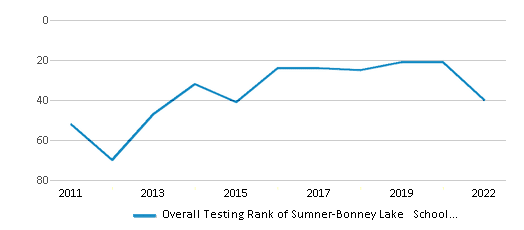
Math Test Scores (% Proficient)
52%
40%

Reading/Language Arts Test Scores (% Proficient)
66%
53%
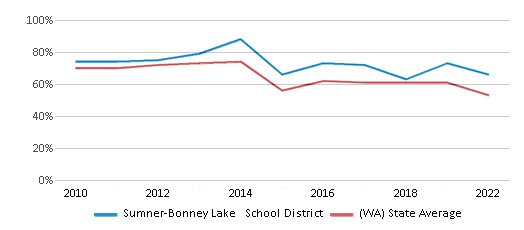
Science Test Scores (% Proficient)
58%
49%
Graduation Rate
92%
84%
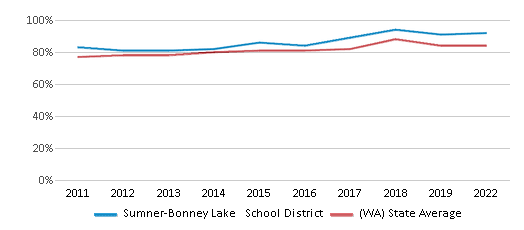
Students by Ethnicity:
Diversity Score
0.56
0.71
# American Indian Students
69 Students
2,844 Students
% American Indian Students
1%
1%
# Asian Students
485 Students
25,971 Students
% Asian Students
4%
9%
# Hispanic Students
1,873 Students
73,094 Students
% Hispanic Students
18%
26%
# Black Students
240 Students
16,473 Students
% Black Students
2%
6%
# White Students
6,706 Students
129,086 Students
% White Students
63%
46%
# Hawaiian Students
73 Students
5,103 Students
% Hawaiian Students
1%
2%
# Two or more races Students
1,224 Students
27,229 Students
% of Two or more races Students
11%
10%
Students by Grade:
# Students in PK Grade:
438
23,952
# Students in K Grade:
667
43,573
# Students in 1st Grade:
723
42,048
# Students in 2nd Grade:
778
43,955
# Students in 3rd Grade:
733
39,809
# Students in 4th Grade:
769
41,098
# Students in 5th Grade:
787
39,252
# Students in 6th Grade:
780
3,085
# Students in 7th Grade:
767
1,010
# Students in 8th Grade:
756
1,067
# Students in 9th Grade:
904
319
# Students in 10th Grade:
962
337
# Students in 11th Grade:
814
333
# Students in 12th Grade:
796
580
# Ungraded Students:
-
-
District Revenue and Spending
The revenue/student of $16,687 in this school district is less than the state median of $18,796. The school district revenue/student has declined by 8% over four school years.
The school district's spending/student of $14,488 is less than the state median of $19,246. The school district spending/student has declined by 8% over four school years.
Total Revenue
$178 MM
$20,715 MM
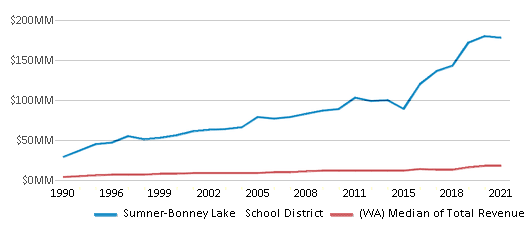
Spending
$155 MM
$21,212 MM
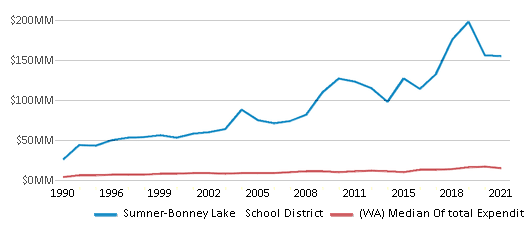
Revenue / Student
$16,687
$18,796
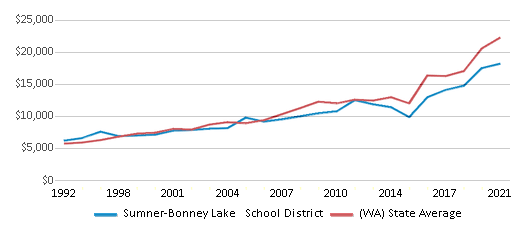
Spending / Student
$14,488
$19,246
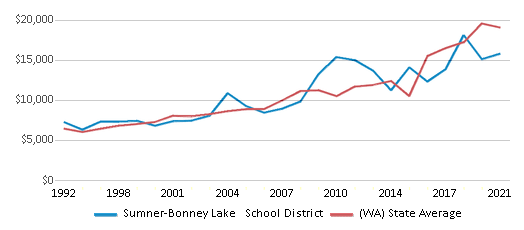
Best Sumner-Bonney Lake School District Public Preschools (2025)
School
(Math and Reading Proficiency)
(Math and Reading Proficiency)
Location
Grades
Students
Rank: #11.
Tehaleh Heights Elementary School
(Math: 75-79% | Reading: 75-79%)
Rank:
Rank:
10/
Top 10%10
17520 Berkeley Parkway East
Bonney Lake, WA 98391
(253) 891-6530
Bonney Lake, WA 98391
(253) 891-6530
Grades: PK-5
| 497 students
Rank: #22.
Maple Lawn Elementary School
(Math: 70% | Reading: 71%)
Rank:
Rank:
9/
Top 20%10
230 Wood Ave
Sumner, WA 98390
(253) 891-4400
Sumner, WA 98390
(253) 891-4400
Grades: PK-5
| 603 students
Rank: #33.
Crestwood Elementary School
(Math: 64% | Reading: 67%)
Rank:
Rank:
9/
Top 20%10
3914 W Tapps Dr E
Sumner, WA 98390
(253) 891-4550
Sumner, WA 98390
(253) 891-4550
Grades: PK-5
| 417 students
Rank: #44.
Bonney Lake Elementary School
(Math: 67% | Reading: 64%)
Rank:
Rank:
9/
Top 20%10
18715 80th St E
Sumner, WA 98390
(253) 891-4450
Sumner, WA 98390
(253) 891-4450
Grades: PK-5
| 424 students
Rank: #55.
Victor Falls Elementary School
(Math: 60% | Reading: 66%)
Rank:
Rank:
9/
Top 20%10
11401 188th Ave Ct. E
Bonney Lake, WA 98391
(253) 891-4700
Bonney Lake, WA 98391
(253) 891-4700
Grades: PK-5
| 515 students
Rank: #66.
Donald Eismann Elementary School
(Math: 49% | Reading: 61%)
Rank:
Rank:
8/
Top 30%10
13802 Canyon View Blvd East
Bonney Lake, WA 98391
(253) 891-4500
Bonney Lake, WA 98391
(253) 891-4500
Grades: PK-5
| 744 students
Rank: #77.
Daffodil Valley Elementary School
(Math: 47% | Reading: 59%)
Rank:
Rank:
7/
Top 50%10
1509 Valley Avenue
Sumner, WA 98390
(253) 891-4600
Sumner, WA 98390
(253) 891-4600
Grades: PK-5
| 521 students
Rank: #88.
Liberty Ridge Elementary School
(Math: 44% | Reading: 51%)
Rank:
Rank:
6/
Top 50%10
12202 209th Ave Ct E
Sumner, WA 98390
(253) 891-4800
Sumner, WA 98390
(253) 891-4800
Grades: PK-5
| 508 students
Rank: n/an/a
Sumner Special Services
Special Education School
1202 Wood Avenue
Sumner, WA 98390
(253) 891-6000
Sumner, WA 98390
(253) 891-6000
Grades: PK
| 52 students
Recent Articles

Year-Round Or Traditional Schedule?
Which is more appropriate for your child? A year-round attendance schedule or traditional schedule? We look at the pros and cons.

Why You Should Encourage Your Child to Join a Sports Team
Participating in team sports has a great many benefits for children, there is no doubt. In this article you will learn what those benefits are.

White Students are Now the Minority in U.S. Public Schools
Increasing birth rates among immigrant families from Asia and Central and South America, combined with lower birth rates among white families, means that for the first time in history, public school students in the United States are majority-minority. This shift in demographics poses difficulties for schools as they work to accommodate children of varying language abilities and socio-economic backgrounds.





